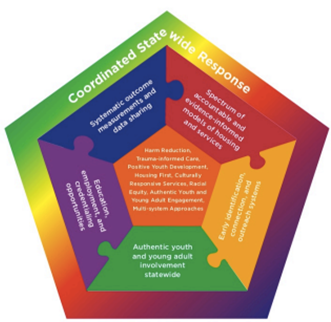Vision:
Our goal is to build a system in which every community in the Commonwealth has coordinated, developmentally appropriate, and trauma-informed resources that are effective, regionally accessible, and reliably funded.
Process:
The Plan integrates recommendations from local, state, and national levels, drawing on the "Federal Framework to End Youth Homelessness" developed by the U.S. Interagency Council on Homelessness, as well as feedback from state and local partners. It centers on eight evidence-based practices and valued principles: harm reduction, trauma-informed care, positive youth development, Housing First, culturally responsive services, racial equity, authentic youth engagement, and multi-system approaches.
Key Statistics:
According to the 2017 MA Youth Count, of the 501 unaccompanied youth identified as experiencing homelessness:
- 22.8% identified as LGBTQ
- 56% identified as Black, Latinx, or Multiracial
- 50% became homeless before age 18
- 39% had been placed in group homes or residential facilities
- 26.4% had experience in the juvenile or criminal justice system
Recommendations:
The Plan presents six primary recommendations, with the overarching goal of implementing a coordinated statewide response to youth homelessness. Achieving this will facilitate progress on all other recommendations through centralized leadership, stronger interagency collaboration, and enhanced regional capacity. The six key recommendations are:
(1) Implement a coordinated statewide response to youth homelessness;
(2) Expand the current spectrum of accountable and evidence informed models of housing and services;

(3) Enhance early identification, connection, and outreach systems to improve young people’s connection to existing resources;
(4) Improve education, employment, and credentialing opportunities in order to support
young people’s access to long term, sustainable employment and income;
(5) Create systematic outcome measurement systems and data sharing opportunities; and
(6) Create a structure to support authentic youth & young adult involvement statewide.
The recommendations and the accompanying action plan serve as a roadmap for ending youth homelessness for the Executive Branch, the Legislature, and regional networks and Continuums of Care .
This plan was written with the urgency of knowing many youth and young adults who are currently experiencing homelessness and housing instability.
“We’re youth and that’s not a good thing. People assume that people our age don’t normally go homeless.” -YYA, 19, ORLEANS
The complete Plan may be found at: https://www.mass.gov/doc/massachusetts-state-plan-to-end-youth-homelessness/download